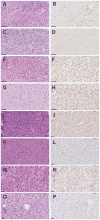Loss of H3K27 tri-methylation is a diagnostic marker for malignant peripheral nerve sheath tumors and an indicator for an inferior survival
- PMID: 26990975
- PMCID: PMC4948583
- DOI: 10.1038/modpathol.2016.45
Loss of H3K27 tri-methylation is a diagnostic marker for malignant peripheral nerve sheath tumors and an indicator for an inferior survival
Erratum in
-
Loss of H3K27 tri-methylation is a diagnostic marker for malignant peripheral nerve sheath tumors and an indicator for an inferior survival.Mod Pathol. 2016 Sep;29(9):1113. doi: 10.1038/modpathol.2016.103. Mod Pathol. 2016. PMID: 27573709 No abstract available.
Abstract
Malignant peripheral nerve sheath tumors (MPNSTs) are aggressive sarcomas that can show overlapping features with benign neurofibromas as well as high-grade sarcomas. Additional diagnostic markers are needed to aid in this often challenging differential diagnosis. Recently mutations in two critical components of the polycomb repressor 2 (PRC2) complex, SUZ12 and EED, were reported to occur specifically in MPNSTs while such mutations are absent in neurofibromas, both in the setting of neurofibromatosis (NF) and sporadic cases. Furthermore, both SUZ12 and EED mutations in MPNSTs were associated with loss of H3K27 tri-methylation, a downstream target of PRC2. Therefore, we tested whether H3K27me3 immunohistochemistry is useful as a diagnostic and prognostic marker for MPNSTs. We performed H3K27me3 immunohistochemistry in 162 primary MPNSTs, 97 neurofibromas and 341 other tumors using tissue microarray. We observed loss of H3K27me3 in 34% (55/162) of all MPNSTs while expression was retained in all neurofibromas including atypical (n=8) and plexiform subtypes (n=24). Within other tumors we detected loss of H3K27me3 in only 7% (24/341). Surprisingly, 60% (9/15) of synovial sarcomas and 38% (3/8) of fibrosarcomatous dermatofibrosarcoma protuberans (DFSP) showed loss of H3K27 trimethylation. Only 1 out of 44 schwannomas showed loss of H3K27me3 and all 4 perineuriomas showed intact H3K27me3. Furthermore, MPNSTs with loss of H3K27 tri-methylation showed inferior survival compared with MPNSTs with intact H3K27 tri-methylation, which was validated in two independent cohorts. Our results indicate that H3K27me3 immunohistochemistry is useful as a diagnostic marker, in which loss of H3K27me3 favors MPNST above neurofibroma. However, H3K27me3 immunohistochemistry is not suitable to distinguish MPNST from its morphological mimicker synovial sarcoma or fibrosarcomatous DFSP. Since loss of H3K27 tri-methylation was related to poorer survival in MPNST, chromatin modification mediated by this specific histone seems to orchestrate more aggressive tumour biology.
Conflict of interest statement
Disclosure/conflict of interest: All authors have no disclosure or conflict of interest.
Figures


References
-
- Fletcher CDM, Bridge JA, Hogendoorn PCW, Mertens F. Malignant peripheral nerve sheath tumour. WHO Classification of Tumours of Soft Tissue and Bone. 2013:187.
-
- Goldblum JR, Folpe AL, Weiss SW. Malignant Peripheral Nerve Sheath Tumors. Soft Tissue Tumors. (sixth) 2014:867.
-
- Kroep JR, Ouali M, Gelderblom H, Le CA, Dekker TJ, Van GM, Hogendoorn PC, Hohenberger P. First-line chemotherapy for malignant peripheral nerve sheath tumor (MPNST) versus other histological soft tissue sarcoma subtypes and as a prognostic factor for MPNST: an EORTC soft tissue and bone sarcoma group study. Ann Oncol. 2011;22:207–14. - PMC - PubMed
-
- Nonaka D, Chiriboga L, Rubin BP. Differential expression of S100 protein subtypes in malignant melanoma, and benign and malignant peripheral nerve sheath tumors. J Cutan Pathol. 2008;35:1014–9. - PubMed
-
- Hirose T, Hasegawa T, Kudo E, Seki K, Sano T, Hizawa K. Malignant peripheral nerve sheath tumors: an immunohistochemical study in relation to ultrastructural features. Hum Pathol. 1992;23:865–70. - PubMed
Publication types
MeSH terms
Substances
Grants and funding
LinkOut - more resources
Full Text Sources
Other Literature Sources
Research Materials

